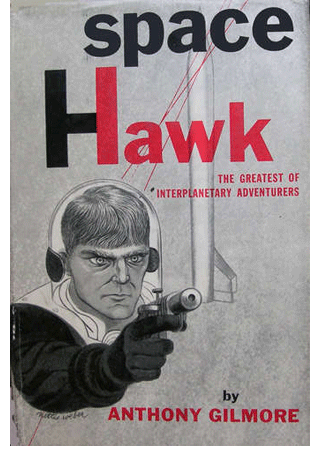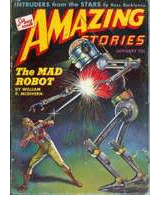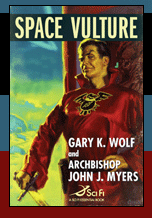The Pulp Science Fiction Heritage of Space Vulture The First Science Fiction Book
Two Boys Ever Read
 The Hawk Carse stories were serialized The Hawk Carse stories were serialized
in the pulp magazine Astounding Stories
in 1931 and 1932. This hardcover edition,
which knitted the stories together
into a novel, came out in 1952.
It was priced at $2.75.
|
This is the cover for Space Hawk, the first Science Fiction book Gary K. Wolf and Archbishop John J. Myers ever read. John found it in their school library. Hardcover Science Fiction was hardly a staple for school libraries in those days. This one had just come in, the first hardcover Science Fiction book in the library's collection. John read it and passed it along to Gary. As the two friends grew older, Gary and John frequently discussed their continued mutual fondness for Science Fiction stories, books, movies, and TV series. During these conversations, they often spoke nostalgically of the book which first got them addicted. Space Hawk. They traded verbatim quotes of its flowery prose. Here's an example. "The Vesuvian quivered, his face still contorted with his last desperate emotion. Then he sagged to the deck. His body twitched and rolled over in a spasm. Almost square between his eyes was a crisp, smooth-burned hole. The air reeked from the smoky stench of charred flesh." Here's the copy from the Space Hawk book jacket.
Hawk Carse came to the frontiers of space when Saturn was the frontier planet, years before law and order were brought to the empires of the far flung stars. It was a time when the outer limits of the Solar System were being terrorized by the space pirate, Dr. Ku Sui, and there was scarcely a pioneer outpost which had not already been the victim of the deadly doctor.
In a curious way, Hawk Carse came to be the only man to stand between Ju Sui and his ambition – an ambition which could be satisfied only when the entire Solar System was under his rule. The battles of these two frontier giants flamed across space and there were many times when it seemed that Hawk Carse had failed.
This is a science fiction classic of the greatest adventurer in space.
Science Fiction's Pulp Era  From the 1920s to 1950s news stands carried a broad variety of pulp science fiction magazines (so-called because they were printed on coarse pulpy paper.) Some of the best known had lurid titles such as Amazing Stories, Astounding Stories, Planet Stories, and Weird Tales. They featured fast paced, imaginative, and exciting science fiction adventures. They were as well known (some would say notorious) for their colorful action-oriented covers as for their stories. From the 1920s to 1950s news stands carried a broad variety of pulp science fiction magazines (so-called because they were printed on coarse pulpy paper.) Some of the best known had lurid titles such as Amazing Stories, Astounding Stories, Planet Stories, and Weird Tales. They featured fast paced, imaginative, and exciting science fiction adventures. They were as well known (some would say notorious) for their colorful action-oriented covers as for their stories.
What red-blooded, action-loving reader could resist exciting stories like The Cave Dwellers of Saturn, After World’s End, Vassals of the Lode-Star, Citadel of the Green Death, The Last Martian, The Thing of Venus, and Thralls of the Endless Night. Some of Science Fiction’s most famous authors began their careers in the puls. Such key shapers of the field as Leigh Brackett, Poul Anderson, Philip K. Dick, Isaac Asimov, Robert A. Heinlein, William Tenn, and Ray Bradbury were proud veterans of the pulps. It only takes a glance at the ads in the pulps to appreciate that the stories were aimed at grown-ups rather than children. The ads promoted correspondence courses for radio-television and auto repair (special rates for World War II veterans,) techniques to preserve thinning hair, nostrums to cure “the heartbreak of psoriasis”, and devices to ease the discomfort of hernias. Full-color back cover ads, usually for cigarettes, helped to defray the costs of the full-color front covers. |


